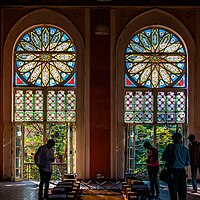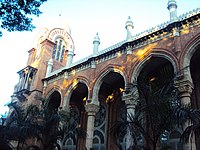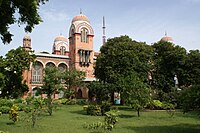
The University of Madras is a public state university in Chennai, Tamil Nadu, India. Established in 1857, it is one of the oldest and among the most prominent universities in India, incorporated by an act of the Legislative Council of India under the British government.

Indo-Saracenic architecture was a revivalist architectural style mostly used by British architects in India in the later 19th century, especially in public and government buildings in the British Raj, and the palaces of rulers of the princely states. It drew stylistic and decorative elements from native Indo-Islamic architecture, especially Mughal architecture, which the British regarded as the classic Indian style. The basic layout and structure of the buildings tended to be close to that used in contemporary buildings in other revivalist styles, such as Gothic revival and Neo-Classical, with specific Indian features and decoration added.

M. A. Chidambaram Stadium, commonly known as the Chepauk Stadium, is a cricket stadium in Chennai, Tamil Nadu, India. Established in 1916, it is the second oldest cricket stadium in the country after Eden Gardens in Kolkata. It is owned and operated by Tamil Nadu Cricket Association (TNCA). The stadium is located at Chepauk, a few hundred meters from Marina beach along the Bay of Bengal.

Chepauk is a locality in Chennai, India. The name Chepauk is popularly used to refer to the M. A. Chidambaram International Cricket Stadium, also known as the Chepauk Stadium. It is also home to the Chepauk Palace, built in the Indo-Saracenic style. The University of Madras campus is yet another prominent landmark of Chepauk. The Central Research laboratory is located here. Chepauk's postal index number (PIN) code is 600005. The main roads of Chepauk are Bells Road and Walajah Road.

Dr. Ambedkar Government Law College, commonly known by its former name Madras Law College, is a law school, located in Chennai (Madras), Tamil Nadu, India. It is also referred to as Government Law College or GLC, Chennai. It was established in 1891. It was renamed in 1990, as Dr. Ambedkar Government Law College, by the Government of Tamil Nadu in commemoration of the birth centenary of B. R. Ambedkar. In 1997, the Government of Tamil Nadu passed an Act which brought the college under the wings of the newly established Tamil Nadu Dr. Ambedkar Law University, splitting the college from the University of Madras.

Chennai architecture is a confluence of many architectural styles. From ancient Tamil temples built by the Pallavas, to the Indo-Saracenic style of the colonial era, to 20th-century steel and chrome of skyscrapers. Chennai has a colonial core in the port area, surrounded by progressively newer areas as one travels away from the port, punctuated with old temples, churches and mosques.
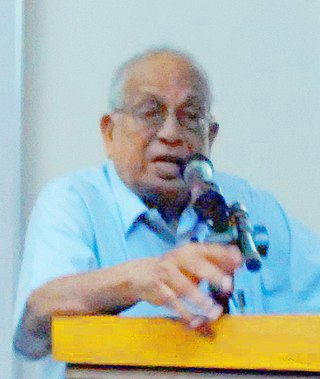
Subbiah Muthiah was an Indian writer, journalist, cartographer, amateur historian and heritage activist known for his writings on the political and cultural history of Chennai city. He was the founder of the fortnightly newspaper Madras Musings and the principal organizer of the annual Madras Day celebrations. Muthiah was also the founder-President of the Madras Book Club.

Muhammad Ali Khan Wallajah, or Muhammed Ali, Wallajah, was the Nawab of the Carnatic from 1749 until his death in 1795. He declared himself Nawab in 1749. This position was disputed between Wallajah and Chanda Sahib. In 1752, after several clashes, Chanda Sahib's forces and his French allies were expelled from Arcot, officially declaring Wallajah as Nawab on 26 August 1765. His reign was recognised by Mughal emperor Shah Alam II.
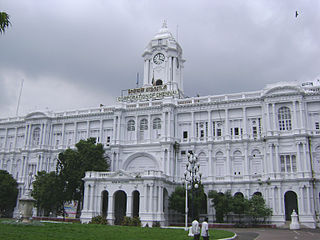
The Ripon Building is the seat and headquarters of the Greater Chennai Corporation in Chennai, Tamil Nadu. It is an example of neoclassical architecture, a combination of Ionic and Corinthian styles. The Ripon Building is an all-white structure and is located near the Chennai Central railway station.
Victoria Technical Institute is an institute established to commemorate the Golden Jubilee of Queen Victoria. The institute promotes traditional handicrafts of South India.

Chepauk Palace was the official residence of the Nawab of Arcot from 1768 to 1855. It is situated in the neighbourhood of Chepauk in Chennai, India and is constructed in the Indo-Saracenic style of architecture.
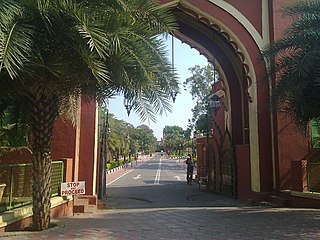
Amir Mahal is the official residence of the titular Nawab of Arcot and his family. Situated in Royapettah, a neighbourhood of Chennai, India, it was constructed in Indo-Saracenic style in 1798, the Amir Mahal has been the residence of the family since 1876. The Prince of Arcot, Nawab Mohammed Abdul Ali, lives in the palace with his family.

Chennakesava Perumal Temple is a Hindu temple situated in the George Town neighbourhood of Chennai city, Tamil Nadu, India. It is dedicated to Chenna Kesava Perumal. There is the nearby Chenna Malleeswarar Temple. They are twin temples. The temple was the first to be built in the new settlement; since the construction of Madras city by the British East India Company. Chennakesava Perumal is a manifestation of the Hindu god Vishnu. And considered as the patron deity of Chennai, Chenna pattanam may be named after the Chenna Kesava Perumal Temple. The word 'chenna' in Telugu means fair not to be confused with tamil word chinna, and the temple was regarded as the main place of the city.

Mallikesvarar Temple or Mallikarjunar Temple is a Hindu temple situated in the neighbourhood of George Town in the city of Chennai, India. It is one of the first Hindu temples to be constructed in the British settlement of Madrasapatnam. There is the nearby Chenna kesava perumal Temple. They are twin temples. This is also called Chenna Malleeswarar temple. Chenna pattanam may be named after this deities. The word 'chenni' in Tamil means face, and the temple was regarded as the face of the city.
Robert Fellowes Chisholm was a British architect who pioneered the Indo-Saracenic style of architecture in Madras.

Rajaji Hall, previously known as the Banqueting Hall, Madras, is a public hall in the city of Chennai, India used for social functions. The hall was built by John Goldingham to commemorate the British victory over Tipu Sultan in the Fourth Anglo-Mysore War.

Southern Railway headquarters administrative building, Chennai, is an Indo-Saracenic structure located adjacent to the Chennai Central on Poonamallee High Road.

Chennai General Post Office (GPO) is located on Rajaji Salai at Parry's Corner, Chennai. It functions in a building built in 1884. It is located opposite to the Chennai Beach suburban railway station. Chennai GPO covers an area of about 23.33 km2 (9.01 sq mi) and serves a population of around 220,000. It has no sub-branch offices.
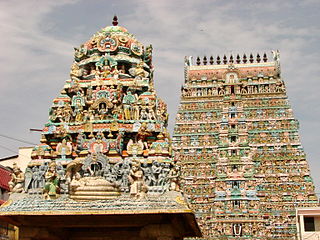
Tamil Nadu is known for its ancient temple architecture. Nearly 33,000 ancient temples, many at least 800 to 2000 years old, are found scattered all over Tamil Nadu. As per Tamil Nadu Hindu Endowments Board, there are 38,615 temples. Most of the largest Hindu Temples reside here. Studded with complex architecture, a variety of sculptures, and rich inscriptions, the temples remain the very essence of the culture and heritage of Tamil land, with historical records dating back to at least 3,000 years.

The "Dr. A. P. J. Abdul Kalam National Memorial" is a mausoleum in memory of A. P. J. Abdul Kalam (1931–2015), the 11th President of India (2002-2007), located in his home town, Rameswaram, Tamil Nadu, India. The memorial was designed and constructed by Defence Research and Development Organisation (DRDO) as a tribute to Kalam and to display the cultural heritage and ethnic diversity of India. It was officially inaugurated by Prime Minister Narendra Modi in July 2017. A symbol of national integration, the memorial is an amalgamation of Mughal and Indian architecture.




